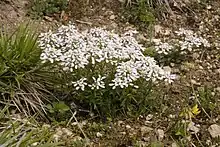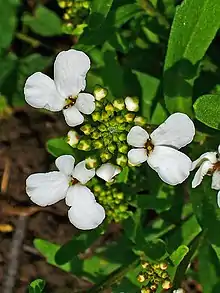Iberis amara
Iberis amara, called wild candytuft, rocket candytuft and bitter candytuft, is a species of flowering plant in the genus Iberis, native to Belgium, France, Germany, Great Britain, Italy, Spain, and Switzerland.[3][4] It has been introduced to numerous locations including Algeria, Sweden, Eastern Europe, the Caucasus, Iraq, Kazakhstan, the Indian Subcontinent, Korea, Far Eastern Russia, New Zealand, Argentina, Ecuador, Hispaniola, the United States, and Canada.[2] It prefers to grow in warm and sunny conditions, in high-calcium soil.[5]
| Iberis amara | |
|---|---|
 | |
| In bloom at the Somme in May | |
 | |
| Close up of flowers, showing asymmetrical petal arrangement | |
| Scientific classification | |
| Kingdom: | Plantae |
| Clade: | Tracheophytes |
| Clade: | Angiosperms |
| Clade: | Eudicots |
| Clade: | Rosids |
| Order: | Brassicales |
| Family: | Brassicaceae |
| Genus: | Iberis |
| Species: | I. amara |
| Binomial name | |
| Iberis amara | |
| Synonyms[2] | |
|
List
| |
References
- Sp. Pl.: 649 (1753)
- "Iberis amara L." Plants of the World Online. Board of Trustees of the Royal Botanic Gardens, Kew. 2017. Retrieved 28 January 2021.
- "Iberis amara wild candytuft". The Royal Horticultural Society. Retrieved 28 January 2021.
Other common names; … annual candytuft, clown's mustard, … sciatica cress
- "Iberis amara coronaria rocket candytuft". The Royal Horticultural Society. Retrieved 28 January 2021.
- Reichling, J.; Saller, R. (2002). "Iberis amara L. (Bittere Schleifenblume) – Profil einer Heilpflanze". Complementary Medicine Research. 9: 21–33. doi:10.1159/000068646. PMID 12618547. S2CID 202658365.
This article is issued from Wikipedia. The text is licensed under Creative Commons - Attribution - Sharealike. Additional terms may apply for the media files.